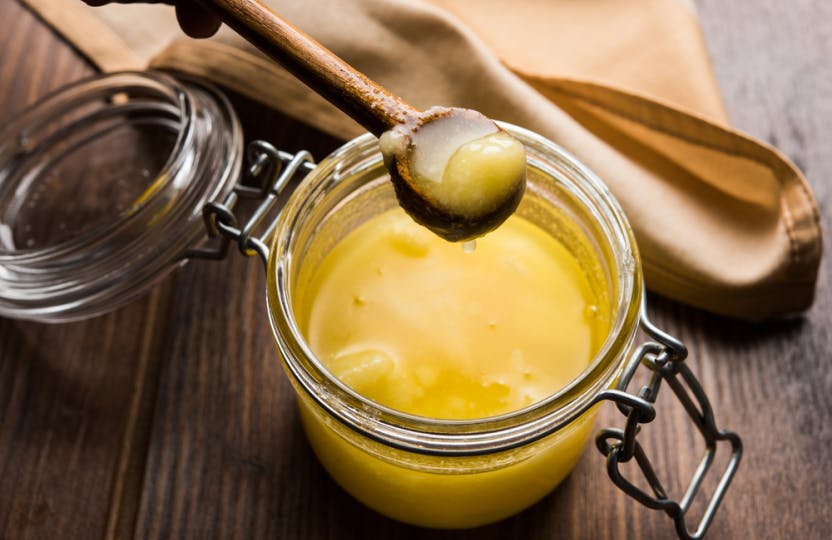
The Golden Elixir
Share
Ghee has been used traditionally in Ayurvedic medicine for gentle detoxification and as a carrier for herbal remedies, ensuring their effective delivery to the body. This tradition-rich food is an indispensable ally in maintaining holistic wellness.
The history of ghee in the Indian subcontinent is intricately woven with religious practices, household routines, and even as a form of currency. It's a symbol of knowledge, the presence of fire, a token of hospitality, and a key ingredient in festive and ordinary meals alike.
Unveiling Ghee's Benefits
- A Rich Source of Nutrients
Contrary to popular belief, ghee isn't just a fat; it's a nutrient-dense powerhouse. Packed with fat-soluble vitamins like A, D, E, and K, along with essential fatty acids, ghee serves as an excellent overall health booster. These vitamins play critical roles in the health of our vision, immune system, skin, bones, and blood.
- Supports Digestion
Ghee stands out for its digestibility. The process of 'clarifying' butter to make ghee involves removing milk solids and water content, enhancing its digestibility for those with lactose intolerance or dairy sensitivity. Furthermore, ghee is a potent source of butyric acid, which has significant anti-inflammatory properties and supports a healthy gut microbiome.
- A Champion in Cooking
Ghee has a high smoke point, which means it doesn't burn easily during cooking, making it a safer and more stable option than many vegetable oils. Its rich, nutty flavor enhances the taste of dishes and is a favorite amongst chefs for perfectly caramelized and moist food.
- Nourishment for the Mind and Body
Ayurveda, the ancient medical system of India, hails ghee for its role in promoting longevity, mental clarity, and strong immunity. Regular consumption of ghee is believed to balance the doshas, aiding in various ailments from joint health to nourishing the brain and nervous system.
The Art of Making Ghee
Ingredients
All you need is unsalted butter and a heavy-bottomed pot or pan. Quality butter will yield the best ghee. It's important to use unsalted butter to avoid excessive sodium in the ghee.
The Process
The technique of making ghee is simple but requires patience. Start with melting the butter over low heat. The butter will separate into three layers - a froth on top, the clarified butter in the middle, and milk solids at the bottom. Continue to simmer until the middle layer becomes a clear golden color and the water has evaporated.
Once the ghee has been clarified, allow it to cool until it is comfortably warm but not hot to the touch before straining. Use a fine-mesh strainer or cheesecloth to remove the milk solids. Store the ghee in a clean, dry glass jar; its purity and potency can keep it fresh for several months at room temperature.
If possible, source grass-fed, organic butter for your ghee. This not only ensures you derive the maximum nutrients from your ghee but also supports sustainable and ethical farming practices.
How to incorporate ghee into your diet.
A Spoonful in the Morning
The Ayurvedic practice of taking a spoonful of ghee in the morning on an empty stomach is believed to kickstart the metabolic processes. It's a gentle detoxifying ritual that sets the digestive system in motion. It also can be used to take herbs and make them more effective.
Cooking Companion
Cooking with ghee imparts a delicious flavor to stir-fries, sautés, roasted vegetables, and baked goods. It is also ideal for high-heat cooking methods like searing and frying.
Boost Beverages
Ghee blends into warm beverages like coffee and herbal teas, promoting a sense of fullness and a slow release of energy. This practice is especially beneficial for those following a ketogenic or low-carb diet.
Sweets and Treats
The richness of ghee harmonizes beautifully with desserts. It is a key ingredient in Indian sweets like halwa and ladoo, and it can be used to prepare a richly flavored fudge or a moist cake.
Depending on how long you cook the butter and the quality of the initial product, ghee can vary in color from a light golden hue to a deep amber. Shorter cooking times will yield a more subtle flavor, while extended cooking can result in a richer, more nutty taste.
For those who can incorporate ghee into their diet, whether for taste, tradition, or health, doing so can be a rewarding culinary exploration. The long list of health benefits, the ease of making it at home, and its versatility make ghee an ingredient worth adding to your repertoire.
Crafting ghee connects us to a timeless tradition of nourishing and healing through food. It stands as a testament to our enduring relationship with the earth's bounties and the art of transforming simple elements into profound sustenance. In the golden essence of ghee, one can savor not just the richness of its flavor but a rich cultural legacy and a promise of robust vitality.